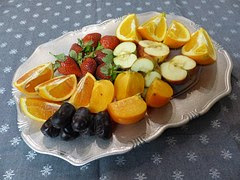Botanically, a fruit is a seed-bearing structure that develops from the ovary of a flower. Vegetables are other edible parts of a plant.
In Elizabethan times, English fruit salads were served hot or cold. They could be as simple as lemons sliced and sprinkled with sugar, or alternately a mixture of many fruits, herbs, nuts, spice and sugar. Flowers such as cowslips, marigold, primrose, or violets were often used; these could be pickled, sweetened or eaten raw.
Most of the vitamin C in fruits is in the skin.
When you eat fruit with its inherent fiber (aka eating the whole fruit) up to 30% of the sugar will be eaten by the microbes in your gut before it can be absorbed.
In Elizabethan times, English fruit salads were served hot or cold. They could be as simple as lemons sliced and sprinkled with sugar, or alternately a mixture of many fruits, herbs, nuts, spice and sugar. Flowers such as cowslips, marigold, primrose, or violets were often used; these could be pickled, sweetened or eaten raw.
Most of the vitamin C in fruits is in the skin.
When you eat fruit with its inherent fiber (aka eating the whole fruit) up to 30% of the sugar will be eaten by the microbes in your gut before it can be absorbed.
Fruit allergies make up about ten percent of all food related allergies.
The scientific study and the cultivation of fruits is called pomology.
Jams are made from actual fruit, jellies are made from fruit juice. Preserves have chunks of fruit, conserves have dried fruit or nuts, and marmalades have peel and pulp.
There is a “Fruit Salad Tree” which can grow up to six different types of fruit. They are multi-grafted trees with different fruits from the same “family” and all the fruits retain their own characteristics e.g. flavour, appearance and ripening times.
The pawpaw, a long bean-shaped berry that grows up to around 18 ounces in weight, is the largest edible fruit indigenous to the United States.
The Durian fruit is so stinky it isn't allowed on public transit in Indonesia.
The national fruit of Jamaica, the ackee, is poisonous in all but one small portion, and that portion is only safe to eat after the fruit has naturally opened on its own. Eating it prematurely or any other part at all causes "Jamaican Vomiting Sickness," which can lead to coma or death.
According to data from the Food and Agriculture Organization of the United Nations, the most consumed fruit in the world is the tomato, followed by bananas.
Avocados, cucumber, eggplant, olives, peapods, and pumpkins are all actually fruits.
The scientific study and the cultivation of fruits is called pomology.
Jams are made from actual fruit, jellies are made from fruit juice. Preserves have chunks of fruit, conserves have dried fruit or nuts, and marmalades have peel and pulp.
There is a “Fruit Salad Tree” which can grow up to six different types of fruit. They are multi-grafted trees with different fruits from the same “family” and all the fruits retain their own characteristics e.g. flavour, appearance and ripening times.
The pawpaw, a long bean-shaped berry that grows up to around 18 ounces in weight, is the largest edible fruit indigenous to the United States.
The Durian fruit is so stinky it isn't allowed on public transit in Indonesia.
The national fruit of Jamaica, the ackee, is poisonous in all but one small portion, and that portion is only safe to eat after the fruit has naturally opened on its own. Eating it prematurely or any other part at all causes "Jamaican Vomiting Sickness," which can lead to coma or death.
According to data from the Food and Agriculture Organization of the United Nations, the most consumed fruit in the world is the tomato, followed by bananas.
Avocados, cucumber, eggplant, olives, peapods, and pumpkins are all actually fruits.
The stickers on fruit are made to be edible, just in case.
Fruit isn't always vegan. Many stores spray their fruit with shellac wax to preserve it, and shellac is derived from insects, making it non-vegan.
Source Food For Thought by Ed Pearce
Source Food For Thought by Ed Pearce



No comments:
Post a Comment